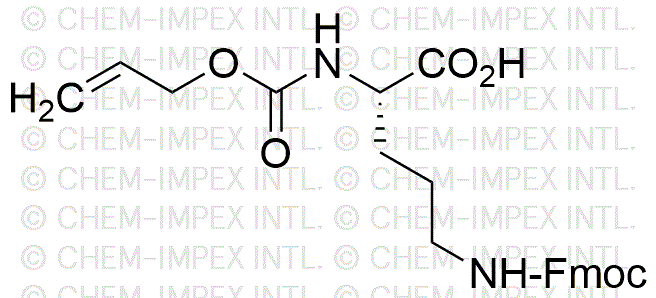Na-Allyloxycarbonyl-Nd-Fmoc-L-ornitine is widely utilized in research focused on:
- Peptide Synthesis: This compound serves as a key building block in the synthesis of peptides, facilitating the introduction of specific functional groups that enhance the properties of the resulting peptides.
- Drug Development: It is employed in the development of novel therapeutics, particularly in the design of peptide-based drugs that target specific biological pathways, offering potential advantages in efficacy and specificity.
- Bioconjugation: The compound is useful in bioconjugation processes, allowing researchers to attach biomolecules to surfaces or other molecules, which is crucial in creating targeted drug delivery systems.
- Protein Engineering: In protein engineering, it aids in modifying proteins to improve their stability and functionality, which is essential for developing more effective biopharmaceuticals.
- Research in Cancer Therapy: It has applications in cancer research, where it can be used to develop targeted therapies that minimize side effects while maximizing therapeutic effects on cancer cells.
General Information
Properties
Safety and Regulations
Applications
Na-Allyloxycarbonyl-Nd-Fmoc-L-ornitine is widely utilized in research focused on:
- Peptide Synthesis: This compound serves as a key building block in the synthesis of peptides, facilitating the introduction of specific functional groups that enhance the properties of the resulting peptides.
- Drug Development: It is employed in the development of novel therapeutics, particularly in the design of peptide-based drugs that target specific biological pathways, offering potential advantages in efficacy and specificity.
- Bioconjugation: The compound is useful in bioconjugation processes, allowing researchers to attach biomolecules to surfaces or other molecules, which is crucial in creating targeted drug delivery systems.
- Protein Engineering: In protein engineering, it aids in modifying proteins to improve their stability and functionality, which is essential for developing more effective biopharmaceuticals.
- Research in Cancer Therapy: It has applications in cancer research, where it can be used to develop targeted therapies that minimize side effects while maximizing therapeutic effects on cancer cells.
Documents
Safety Data Sheets (SDS)
The SDS provides comprehensive safety information on handling, storage, and disposal of the product.
Product Specification (PS)
The PS provides a comprehensive breakdown of the product’s properties, including chemical composition, physical state, purity, and storage requirements. It also details acceptable quality ranges and the product's intended applications.
Certificates of Analysis (COA)
Search for Certificates of Analysis (COA) by entering the products Lot Number. Lot and Batch Numbers can be found on a product’s label following the words ‘Lot’ or ‘Batch’.
*Catalog Number
*Lot Number
Certificates Of Origin (COO)
This COO confirms the country where the product was manufactured, and also details the materials and components used in it and whether it is derived from natural, synthetic, or other specific sources. This certificate may be required for customs, trade, and regulatory compliance.
*Catalog Number
*Lot Number
Safety Data Sheets (SDS)
The SDS provides comprehensive safety information on handling, storage, and disposal of the product.
DownloadProduct Specification (PS)
The PS provides a comprehensive breakdown of the product’s properties, including chemical composition, physical state, purity, and storage requirements. It also details acceptable quality ranges and the product's intended applications.
DownloadCertificates of Analysis (COA)
Search for Certificates of Analysis (COA) by entering the products Lot Number. Lot and Batch Numbers can be found on a product’s label following the words ‘Lot’ or ‘Batch’.
*Catalog Number
*Lot Number
Certificates Of Origin (COO)
This COO confirms the country where the product was manufactured, and also details the materials and components used in it and whether it is derived from natural, synthetic, or other specific sources. This certificate may be required for customs, trade, and regulatory compliance.


